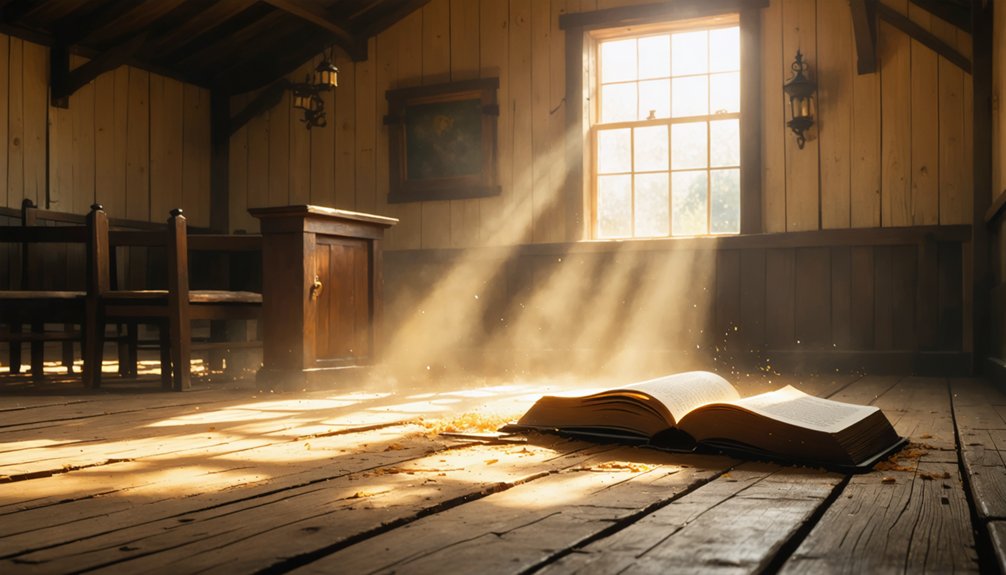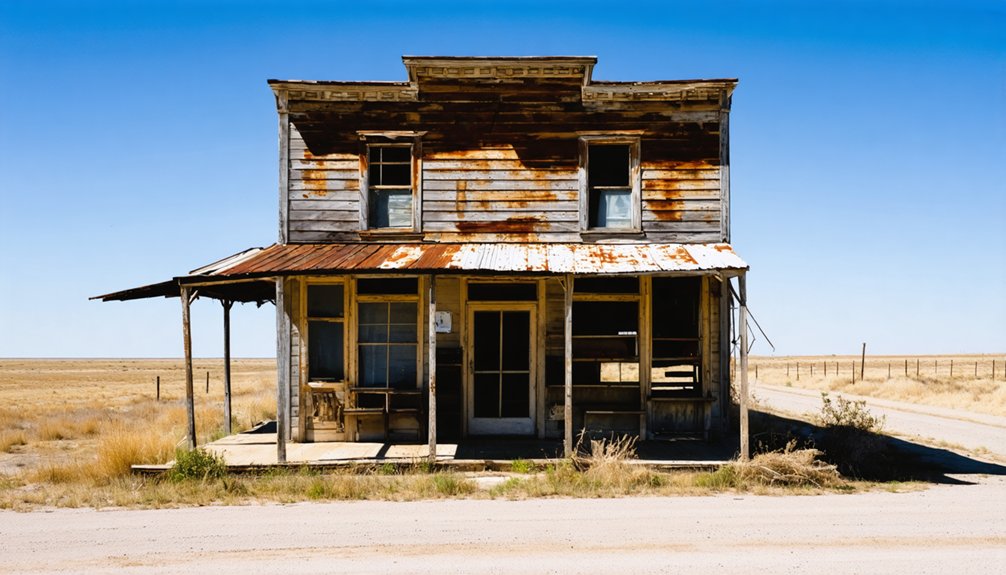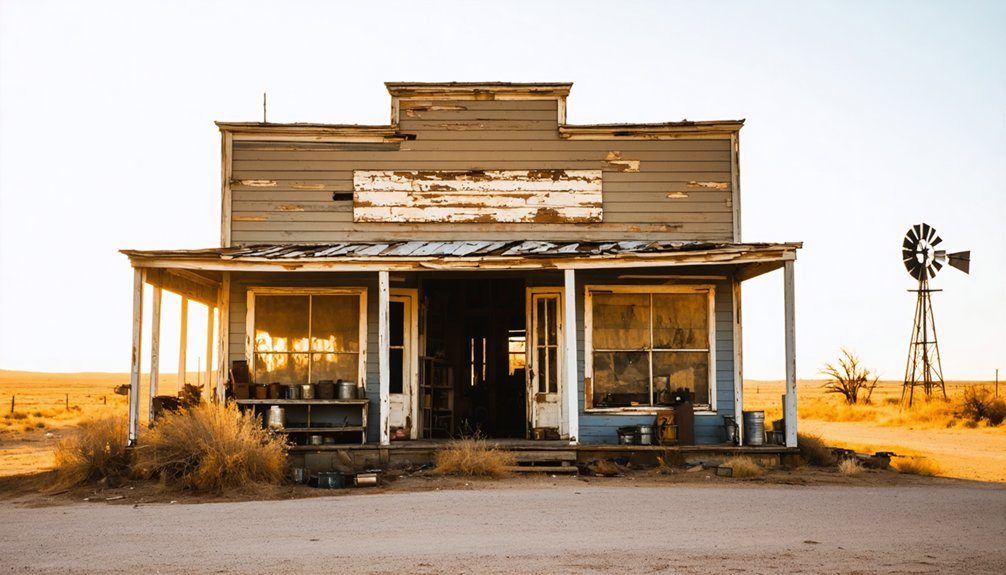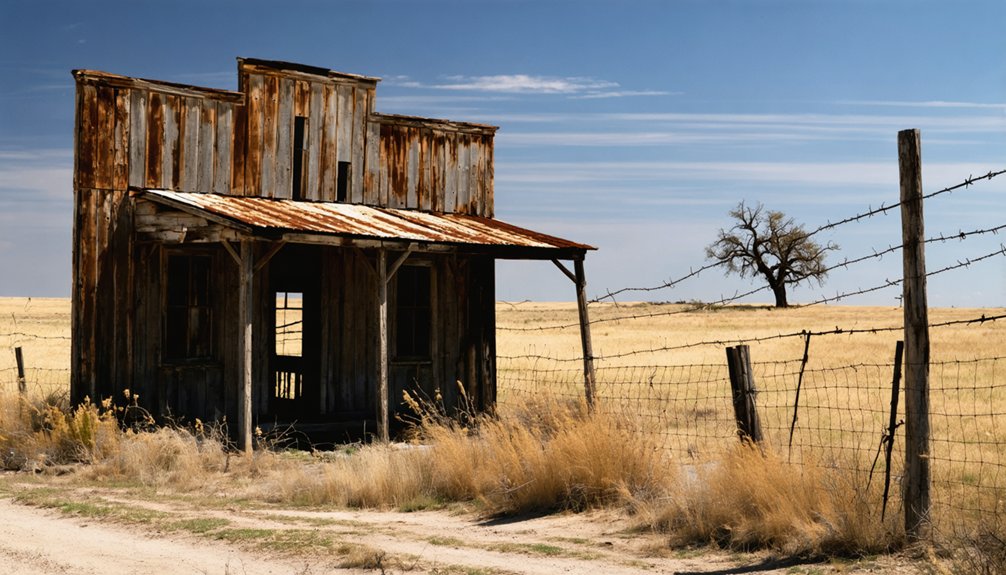You’ll find Doan’s Crossing, established in 1878 by Jonathan Doan, at a crucial Red River crossing point along the Great Western Trail. The trading post processed over 301,000 cattle in 1881 alone, serving as an essential hub where cowboys, settlers, and Native Americans converged. Though fire claimed the original adobe structure in 1922, and railroads diminished its importance, the site’s weathered remains still whisper stories of Texas’s frontier legacy.
Key Takeaways
- Doan’s Crossing began as a trading post in 1878 along the Great Western Trail, established by Jonathan Doan and family.
- The settlement included a trading post, hotel, saloon, and school before declining due to railroad expansion and reduced cattle drives.
- A devastating fire in 1922 destroyed the original adobe trading post, accelerating the location’s transformation into a ghost town.
- The original 1879 adobe trading post structure still stands but remains privately owned with restricted public access.
- Historical markers commemorate the site’s significance, while annual events like the May Day picnic maintain community connections.
The Birth of a Frontier Trading Post
In 1878, Jonathan Doan, alongside his brother Calvin and nephew Corwin F., established a trading post near Texas’s Red River that would become a cornerstone of frontier commerce.
You’ll find their story began in Ohio, following buffalo hunters southwest through Kansas before reaching Texas by 1870.
Their first structure was modest – picket walls, dirt roof, and space for both family living and merchandise. The trading post’s strategic location at a Red River crossing made it perfect for cultural exchanges between settlers, cowboys, and Native Americans.
From simple walls and dirt roof emerged a vital hub where cultures crossed paths at the Red River frontier.
When Corwin became the first postmaster in 1879, the settlement gained official recognition. The store primarily supplied ammunition and groceries to travelers. They built an adobe store between 1879-1881, which stands today as the only surviving original structure.
The post flourished during the cattle drive era, with millions of cattle crossing nearby. In 1884, the community started their beloved Doans Picnic, which continues as Texas’s oldest pioneer celebration.
Life Along the Great Western Trail
While post-Civil War Texas faced widespread economic devastation, the Great Western Trail emerged as an essential lifeline for the state’s recovery. These drives revitalized the economy by establishing open range ranching across multiple states.
You’d find young cowboys of diverse backgrounds – white, Black, and Hispanic riders – working together in crews of 10 to 12 men, driving herds of 3,000 cattle northward for $40 monthly wages.
The cowboy camaraderie developed through shared challenges along the 2,000-mile journey. At its peak in 1881, an impressive 301,000 head of cattle were driven along the trail.
You’d experience rigorous days in the saddle, maneuvering treacherous river crossings and vast table-top grasslands. Daily life meant camping under stars, maintaining strict trail etiquette, and performing cattle branding while staying vigilant against rustlers.
Military guides like Fort Griffin’s Champ Means helped crews locate essential watering holes, ensuring successful passage through the demanding terrain of the Great Plains.
The Doan Family Legacy
Descended from a distinguished Ohio family, Corwin F. Doan carried forward his father Azariah’s legacy of leadership when he followed his uncle Jonathan to the Texas frontier.
The Doan family’s pioneering spirit transformed a humble trading post with buffalo-hide doors into a crucial commercial hub along the Great Western Trail. You’ll find their influence reflected in the seven stores they established across Texas and Oklahoma, serving countless cattle drives and settlers. As first postmaster of the area, Corwin helped establish vital communication links for the growing frontier community.
Their adobe trading post, which still stands today, represents more than just commerce – it’s a symbol of their diplomatic success with Native American tribes and their role in connecting diverse peoples. Eliza Ellen Lide became an integral part of this frontier success story when she married Corwin in 1871.
From governors to Comanche leaders like Quanah Parker, the Doans created a crossroads of culture that defined the American frontier experience.
Native American Relations and Trade
You’ll find that Doan’s Crossing trading post served as an essential cultural exchange hub where Native Americans, particularly Comanche chief Quanah Parker, regularly conducted business and socialized around the store’s large fireplace.
Native Americans often approached cattle drives demanding beef as compensation since the herds grazed on their former lands, receiving only $3.00 annually from the government for subsistence.
The Doan family, especially Corwin Doan, cultivated strong personal friendships with tribal leaders, fostering trust that extended beyond mere commerce. The old adobe house provided shelter for a diverse range of visitors, from tribal members to governors alike.
These relationships helped maintain peaceful interactions between settlers and Native Americans in the territory, with the trading post receiving regular supply shipments that served both communities’ needs.
Trading Post Cultural Exchange
As a pivotal frontier establishment in 1878, Doan’s Trading Post emerged as a crucial hub for cultural and economic exchange between Native Americans, settlers, and cowboys.
Notable leaders like Quanah Parker and Santanta engaged in diplomatic discussions at the trading post while warning settlers about potential dangers. You’d find diverse groups gathering around the adobe structure’s central fireplace, where cultural narratives and traditions were shared with mutual respect.
The trading post’s strategic location along the Red River created a sanctuary where English lords, bankers, and tribal members could interact freely.
- The post’s hearth served as a communal space where different peoples observed traditional hospitality practices.
- Settlers and Native Americans exchanged ideas and customs alongside trade goods.
- The multicultural atmosphere fostered interdependent relationships between communities adapting to frontier life.
Quanah Parker’s Regular Visits
Among the most prominent visitors to Doan’s Crossing, Quanah Parker stands out as a transformative figure who shaped Native American relations throughout the 1880s.
After serving as chief of Quahada and resisting US forces, Quanah’s diplomatic approach at Doan’s represented a significant shift in leadership style.
You’ll find evidence of Quanah’s influence in his frequent interactions with cattlemen and traders near Doan’s Store, where he skillfully balanced Comanche traditions with pragmatic diplomacy.
During peak cattle drive seasons, Quanah leveraged his position to secure grazing fees for reservation lands while fostering cooperative relationships between Comanche riders and cowboys.
His cultural diplomacy manifested through organized horsemanship displays and practical assistance at river crossings.
You’ll discover that these visits weren’t just social occasions – they represented strategic leadership during a critical change period, as Quanah worked to protect Comanche interests while adapting to rapid changes in the region’s economic and political landscape.
Tribal Territory Peace Agreements
Located at the convergence of Texas and Indian Territory, Doan’s Crossing fostered peaceful relationships between Native tribes and cattle drivers through informal yet effective peace agreements.
Through tribal diplomacy, Native groups like the Comanche, Cheyenne, and Arapaho established grazing agreements that allowed cattle herds safe passage in exchange for livestock and supplies.
- Native Americans received cattle as “toll payments” for grazing rights on their lands, often accepting thinner or less valuable livestock.
- Doan’s Store served as a trading hub where tribes could exchange goods and maintain social connections with settlers and cowboys.
- The peaceful coexistence benefited both parties – tribes gained supplemental food sources as buffalo diminished, while cattlemen secured safe passage through Indian Territory.
Daily Operations at the Crossing
When cattle drives reached Doan’s Crossing in the late 1870s, they encountered a well-organized operation that processed hundreds of thousands of livestock annually.
You’d find livestock inspectors examining your cattle for health and ownership while workers maintained a “bridge of straw” to help you navigate treacherous river sections. For your cattle drive logistics, you’d stop at the trading post to stock up on groceries, ammunition, and collect mail before heading into Indian Territory.
The crossing’s daily operations centered around managing the ford’s challenges, including quicksand and strong currents. You’d pay a fee for crossing assistance, and after 1888, you might’ve encountered Fort Sill troops providing escort services as you moved your herds north toward the Washita River.
Tales From the Trail: Notable Visitors

You’d find a fascinating mix of frontier personalities at Doan’s Crossing, from Chief Quanah Parker‘s diplomatic visits to the annual gatherings of Old Time Trail Drivers attended by Charles F. Doan.
The trading post’s strategic location made it a natural meeting point where Native American leaders, buffalo hunters, and cattle drivers would cross paths, creating a unique social atmosphere at this Red River waypoint.
The site’s historical significance drew notable figures whose presence was documented in Emma Doan’s accounts and Corwin Doan’s records, offering a glimpse into the dynamic cultural interactions of the American frontier.
Famous Faces at Doan’s
Three prominent groups of visitors left their mark on Doan’s Crossing during its heyday: Native American leaders like Chief Quanah Parker, cattle drivers moving millions of head north, and military personnel from nearby Fort Sill.
These famous faces shaped the pioneer stories that define this historic crossing point on the Red River.
- Charles F. Doan managed the store and kept detailed records of trail drivers, preserving their stories through annual reunions that celebrated the frontier spirit.
- Chief Quanah Parker’s visits represented diplomatic relations between settlers and Native Americans, though other encounters with Kiowa raiders reminded residents of ongoing tensions.
- The crossing served as a significant checkpoint where cattle inspectors from the Southwestern Cattle Raisers’ Association verified ownership of the estimated 3-6 million cattle that passed through during peak years.
Trail Life Social Mix
Beyond the notable figures who frequented Doan’s Crossing, the store’s daily social fabric wove together an extraordinary mix of humanity from the American frontier.
You’d find trail drivers sharing stories by the fireplace alongside English lords, while lawyers and tramps mingled with buffalo hunters and settlers. The store served as more than just a trading post – it became a vibrant cultural crossroads where diverse groups forged unexpected bonds.
At the heart of these cultural interactions was the Doan family, who cultivated relationships across social boundaries, particularly with Comanche Chief Quanah Parker.
The store’s welcoming atmosphere encouraged meaningful exchanges between ranchers, Native Americans, and travelers of all backgrounds. This unique social environment crystallized annually at the May Day picnic, a celebration that’s continued since 1884, commemorating the trail-driving heritage.
Architecture and Settlement Layout
The architectural legacy of Doan’s Crossing centers on Corwin F. Doan’s unique adobe trading post, built around 1880. You’ll find this 17 by 27.5-foot structure remarkable for its rare use of sun-dried mud bricks in North Texas frontier architecture.
The settlement’s expansion reflects its architectural significance through strategic positioning near a Red River crossing, with buildings organized to support the bustling cattle trade.
Positioned strategically near Red River, Doan’s Crossing grew into a well-planned frontier hub serving the region’s thriving cattle industry.
- The trading post served dual purposes: one end for commerce, the other for family quarters, featuring a central fireplace.
- Settlement layout clustered around the store, with essential frontier amenities like a hotel, saloon, and school within walking distance.
- Construction evolved from simple picket houses to more substantial structures, including log cabins and frame buildings, showing the community’s growth.
Commerce and Community Growth

You’ll find that Doan’s Store, established in 1878, operated as an essential trading post that supplied essential goods like flour, ammunition, and medicine to cattlemen traversing the Great Western Trail.
The store’s strategic location at the Red River crossing helped it flourish into a commercial hub, processing over 300,000 head of cattle in 1881 alone and serving as both a post office and social gathering point.
As the community grew around the trading post, you’d see the development of adobe houses and frame dwellings, while the store continued its role as a sanctuary where cowboys, buffalo hunters, and settlers could gather for warmth and companionship around its large fireplace.
Trading Post Operations
Located strategically near a bend in the Red River, Doan’s Trading Post operated as a vital commercial hub from its 1878 establishment, serving as the last major supply point before cattle drives crossed into Indian Territory.
The post stocked essential trading post supplies from regional centers like Denison, Sherman, and Gainesville, ensuring cattle drive essentials were always available. You’d find the store bustling with a diverse clientele of cattlemen, buffalo hunters, and settlers seeking ammunition and groceries.
- The original structure combined a store and family dwelling, built with pickets and adobe.
- Regular shipments arrived from major regional centers to maintain robust inventory.
- The trading post’s fireplace became a gathering spot where Indians, settlers, and hunters freely mingled.
Trail Economy Impact
During the late 1800s, Doan’s Crossing emerged as an essential economic engine that transformed a simple river crossing into a thriving commercial hub.
You’ll find that this significant stop along the Great Western Trail supported a dynamic trail economy through its trading post, which supplied cowboys, settlers, and buffalo hunters with critical provisions before they entered Indian Territory.
The site’s strategic location fostered freight movement and commerce between Texas ranchers and Kansas railheads, while supporting a growing community complete with a hotel, saloon, and school.
You can trace how the 1879 establishment of a post office strengthened the settlement’s role in regional trade networks.
The crossing’s economic influence extended beyond cattle drives, as it served as a meeting point for diverse groups, including notable visitors like Quanah Parker, until changing trail routes eventually led to its decline.
Social Hub Development
While Jonathan and Corwin Doan initially established their trading post in 1878 as a modest dirt-roofed structure, it rapidly evolved into the beating heart of a vibrant frontier community.
You’d have found a bustling social hub where cowboys, settlers, Native Americans, and buffalo hunters gathered for commerce and camaraderie. The store’s influence expanded beyond trade to host social gatherings and cultural celebrations that united diverse populations.
- The establishment grew to include a hotel, saloon, and school, creating a complete community center.
- Annual picnics and community events strengthened local bonds and cultural exchange.
- The Doan household served as a sanctuary where notable figures like Comanche Chief Quannah Parker would meet, fostering cross-cultural relationships.
The End of an Era

As railroads pushed deeper into cattle country in the early 20th century, Doan’s Crossing‘s significance as an essential waypoint on the Great Western Trail began to fade.
The transportation evolution rendered long cattle drives less necessary, while the 1922 fire that destroyed the original adobe trading post symbolized the cattle drive decline.
You’d have witnessed dramatic changes as the once-bustling settlement transformed into a ghost town.
The post office, store, and saloon that served countless drovers closed their doors.
Even Corwin Doan’s family moved away, and the steady stream of cowboys and buffalo hunters dwindled to nothing.
The site’s strategic importance at the Red River ford became irrelevant as new routes and infrastructure developed, leaving only remnants of its frontier past.
Preserving Doan’s Crossing Today
Modern preservation efforts keep Doan’s Crossing’s frontier legacy alive, despite its transformation into a ghost town.
You’ll find the original 1879 adobe trading post still standing, though it’s privately owned. The site’s historical significance draws community involvement through annual events like the May Day picnic, running continuously since 1884.
- The adobe structure remains protected through private ownership, with public access limited to external viewing and photography.
- Historical markers and monuments installed near the crossing help visitors understand its role in cattle drive history.
- Local historical societies actively research and promote the site’s heritage through publications, guided tours, and reenactments.
Preservation work continues through partnerships between private owners, local governments, and volunteer groups, focusing on protecting the ruins from natural threats while maintaining this tangible link to Texas frontier history.
Frequently Asked Questions
What Was the Average Salary of a Worker at Doan’s Store?
You’d find average wages at Doan’s Store weren’t documented, but store operations likely paid frontier-standard compensation of a few dollars weekly plus room and board during 1876-1895.
How Many Children Attended the School During Its Peak Years?
Picture a one-room schoolhouse on the frontier: you’d find between 10-30 students attending during peak years in the 1880s. The school’s enrollment varied seasonally as families moved through the settlement.
What Specific Items Were Most Commonly Traded With Comanche Tribes?
You’ll find that Comanche trade centered heavily on metal items like knives, cartridges, and arrow spikes, alongside essential goods including coffee, flour, beads, and calico cloth for Native American artifacts.
Did Any Famous Outlaws or Bandits Ever Visit Doan’s Crossing?
Despite 100+ years of frontier history, you won’t find any verified records of famous outlaws at this crossing. While outlaw legends and bandit encounters exist locally, they’re not supported by historical evidence.
What Was the Typical Cost of Supplies for Crossing Cattle Herds?
You’d spend about $8 per head for cattle supplies, plus crossing costs like bridge-of-straw fees, Indian tolls of 3-4 cattle, and worker wages ranging from $50-100 per drive.
References
- https://www.redriverhistorian.com/post/crossing-at-doans-store
- https://texoso66.com/2016/10/20/doans-crossing/
- https://www.lubbockonline.com/story/lifestyle/columns/2017/05/27/caprock-chronicles-doan-s-crossing-red-river-important-part-great/14825434007/
- https://www.okhistory.org/publications/enc/entry?entry=DO003
- https://ahgp.org/ok/doans-crossing.html
- https://www.tshaonline.org/handbook/entries/doans-tx
- https://homerrotary.org/stories/on-the-trail-of-history
- https://www.ghosttowns.com/states/tx/doanscrossing.html
- https://nataliebright.com/2024/04/doans-crossing/
- https://texoso66.com/2023/01/26/corwin-f-and-lide-doan/



